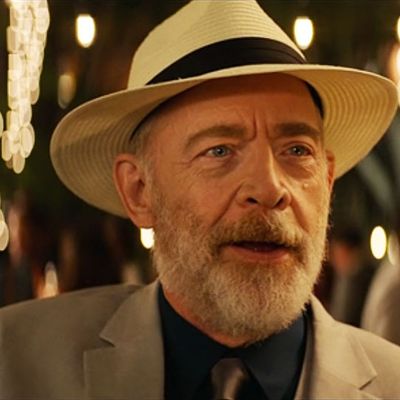
Mid-credit stingers aren’t made for the streaming-only-era — it’s just too easy to move on to the next title in the queue and skip a moment tucked away after a movie seems to have ended. If Palm Springs had made it to theaters, the scene that pops up some 15 seconds after everything cuts to black would have been unavoidable to anyone who hadn’t immediately sprinted off to the bathroom. But theaters have been closed for months now, and on home viewing, the sequence is easy to miss. Hit stop once director Max Barbakow’s name comes up, and you’ll leave the movie thinking that Nyles (Andy Samberg) and Sarah (Cristin Milioti) found their way out of the time loop they’d been trapped in while leaving Roy (J.K. Simmons) stranded in perpetuity. Which would be kind of a dick move for a pair of otherwise endearing lovers!
The epilogue makes it clear that Sarah sent her research to Roy before she and Nyles exploded their way out of their temporal trap — and that her “pretty crazy theory” indeed works. Roy, back in his three-piece suit and Panama, tracks Nyles down at the wedding they’ve each attended approximately an infinite amount of times, only to find that Nyles no longer has any idea who he is. This version of Nyles has reset along with everyone else, and is going through the day for what is, to him, the first and only time. He’s never met Roy, never partied with him, never been periodically hunted and tortured by him. He also never showed Roy the mysterious desert cave that got them into this mess in the first place. Is this a paradox? Are there multiple universes involved in this delightful romantic comedy? These are questions I can’t answer, having yet to complete my doctorate in high-concept movie physics. The astonished smile that spreads over Roy’s face as he realizes what this means implies that he’s soon going to be making his own bomb-enabled exit from the never-ending November 9.
Or, you know, maybe he won’t. Groundhog Day, the movie that Palm Springs owes its most obvious debt to, is one about a character who finds himself reliving February 2 again and again until he makes peace with his situation (and with himself). “No matter what happens tomorrow, or for the rest of my life, I’m happy now because I love you,” Phil Connors (Bill Murray) tells Rita (Andie MacDowell) in the last night before he’s freed to move forward. Nyles’s climactic speech to Sarah in front of the cave echoes that: “I hope that blowing ourselves up works. But it’s really irrelevant to me as long as I’m with you. And if it kills us, well, then I’d rather die with you than live in this world without you.” And yet, what Nyles goes through is actually nothing like what Phil does, emotionally. Nyles has already achieved a kind of nihilistic, nothing-matters enlightenment by the time the movie starts, content to coast on forever.
His progress is about learning to engage with other people again — notably, Sarah, whom he declares himself ready to build a life with, right before the time-space continuum detonates around them. It’s Roy whose mostly offscreen journey parallels Phil, in that he learns to appreciate the beauty of the moment, to relinquish his dissatisfactions and accept and love what he already has. When Nyles first tells the story of how Roy ended up in the time loop, Roy is a solo attendee looking for drugs and muttering about how marriage is a bottomless pit of sorrow that makes you forget who you are. Roy’s Punxsutawney is a tract house in Irvine that he shares with a woman he’d never planned to marry and two kids he felt trapped into having. He’s a figure of roiling resentment who declares a night spent doing blow with a stranger to be the best of his life. But when Nyles looks him up again, after some unknown stretch of eternity in the time loop has passed, Roy has changed. He’s happily marinating tuna steaks for the grill, and sitting contentedly in his yard watching his twins play.
Palm Springs is a movie about marriage, and about how part of what it means to settle down with someone is getting over the fear of every day being the same. For Nyles, November 9 is a bubble to hide in, and for Sarah, it’s a snare she has to fight her way out of, and when the two finally seem to successfully eject themselves from the date, they go back to lounging in the pool by that house that doesn’t belong to them, because the point is not that they have to do something new, but that they could. But for Roy, the place in which he’d previously felt trapped becomes a suburban slice of paradise, not because his situation has changed, but because he has. Maybe leaving is beside the point. When Phil finally wakes up on February 3, and comes out to greet the new wintery morning in the town he’s been stuck in for decades, the first thing he says is “Let’s live here!”
And then he does add, “We’ll rent to start.” Nothing wrong with keeping a few options open, after all.


